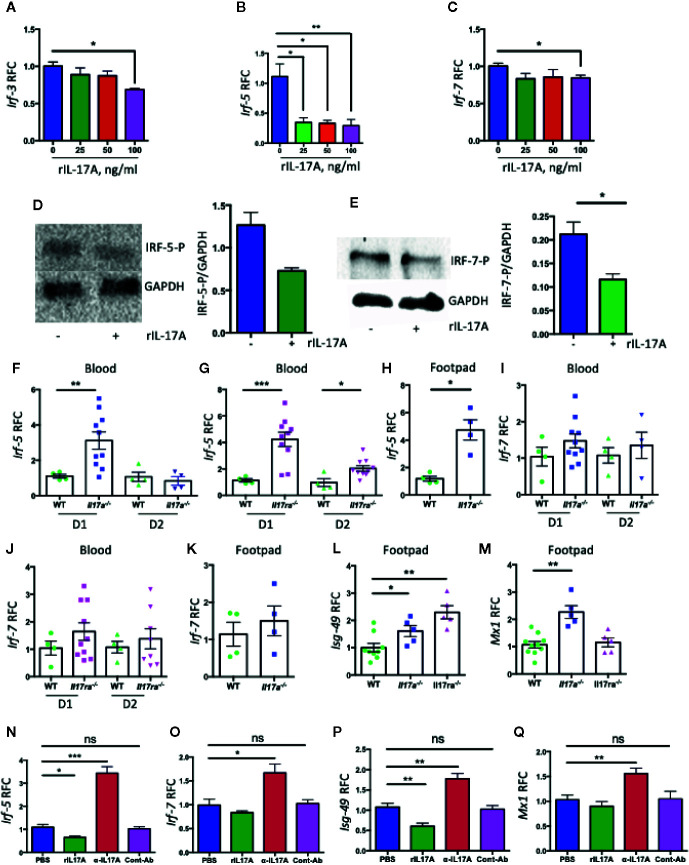Figure 5.
IL-17A downregulates the expression of Irf5 and Irf7 during CHIKV infection. NIH3T3 cells were infected with CHIKV (MOI = 1) and simultaneously treated with indicated concentrations of rIL-17A for 48 h. The transcripts of Irf-3 (A), Irf-5 (B), and Irf-7 (C) were measured by QPCR and expressed as RFC after normalization to cellular β-actin mRNA. (D) NIH3T3 cells were infected with CHIKV (MOI = 1) for 24 h in the presence of IL-17A (100 ng/ml) and indicated proteins in the cell lysates were analyzed by immunoblotting (left) and the ratio of phosphorylated IRF-5 to GAPDH was calculated by densitometric measurement by using ImageLab (right). (E) The immunoblotting analysis was done similarly for IRF-7 and GAPDH (left), and the ratio of phosphorylated IRF-7 to GAPDH was calculated by densitometric measurement by using ImageLab (right). (F, G) WT (n = 4), Il17a−/− (n = 10), and Il17ra−/− (n = 10) mice were infected with 1 × 105 PFU of CHIKV via footpad. Blood was collected on days 1 and 2 post-infection, and the mRNA levels of Irf-5 were measured and normalized to β-actin mRNA between WT and Il17a−/− mice (F), and WT and Il17ra−/− mice (G). Footpads were collected from selected WT (n = 4) and Il17a−/− (n = 4) mice on D1 p.i., and the mRNA level of Irf-5 was measured and normalized to β-actin mRNA between WT and Il17a−/− mice (H). The mRNA levels of Irf-7 were measured in the blood of Il17a−/− mice (I), the blood of Il17ra−/− mice (J), and the footpads of Il17a−/− mice (K). (L, M) Isg-49 and Mx1 mRNAs in the footpads (n = 5 to 10/group) on D1 p.i. (N–Q) NIH3T3 cells were infected with CHIKV (1 MOI) in the presence of IL-17A, anti-Il17A antibody or 4G2 control antibody for 24 h. The level of Irf-5 (N), Irf-7 (O), Isg-49 (P), and Mx1 (Q) were measured and normalized to cellular β-actin mRNA. The data (A–C and N–Q) represent the results of two independent experiments carried out in triplicates, and analyzed by one-way ANOVA followed by Turkey’s test, (*, **, and *** denote p < 0.05, p < 0.01, and p < 0.001 respectively, when compared to untreated control). The results (F–M) represent three independent experiments analyzed by a two-tailed Student t-test, (*, **, and *** denote p < 0.05, p < 0.01, and p < 0.001 respectively, when compared to WT controls). ns denotes not significant.

